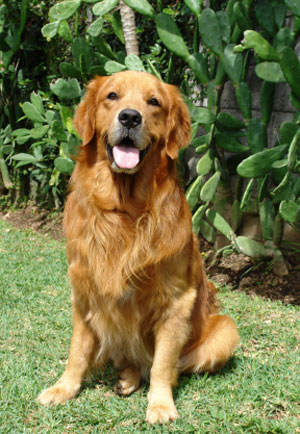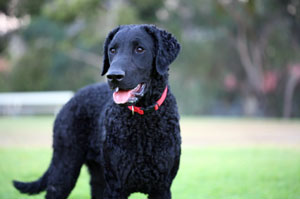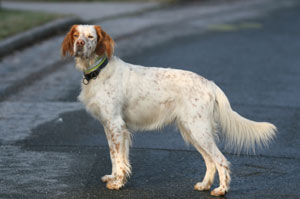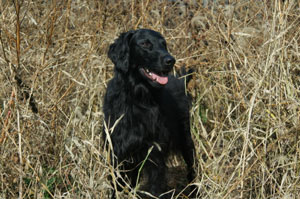
Personality: This people-loving breed is easy to fall head-over-heels in love with due to its beautiful temperament and love without reservation loyalty. It is the perfect family pet and is full of life and warmth. However, the Golden needs to be taken in as part of the family.
Suitability: The Golden is perfect for almost any situation and will be the ideal pet for singles, families and especially children. Your pooch will remain happy, as long as it is taken in as a valued member of the family, but will become depressed if left to its own devices outside.
Favourite Activities: The Golden loves regular daily outings and enjoys obedience and agility exercises. This breed also adores swimming and still exhibits strong retriever instincts. Its most favoured activity, however, will be spending as much time as possible with its family.
Favourite activities: The Golden loves regular daily outings and enjoys obedience and agility exercises. This breed also adores swimming and still exhibits strong retriever instincts. Its most favoured activity, however, will be spending as much time as possible with its family.
Watchdog Qualities: While the Golden will bark and alert its family to strangers approaching the property, this is basically a people-loving breed and should not be acquired for guard-dog purposes. The closest it will come to protective behaviour is perhaps knocking someone around the face with a madly wagging tail!
If you’re after a loyal, adorable and exuberant dog that will love and treasure you without reservation, Michelle Segal discovers you can’t go past the dazzling Golden Retriever.
With its beautiful golden coat and affectionate nature, the Golden Retriever is an icon of the dog world. Extremely popular and adored for its beautiful nature, the Golden makes the ideal companion.
It was in 19th-century England and Scotland that this breed became recognised for its irreplaceable qualities of loyalty and hard work. Bred to retrieve wild birds on land as well as in water, the Golden would serve alongside its hunter-owners and proved to be the ideal assistant.
Today, the Golden is primarily a companion and family pet, but still excels in sports such as agility, obedience and field trials.
Part of the pack
It was 38 years ago when Rose Easton got her first Golden Retriever, and she has never looked back. My mum used to breed Spaniels, but I wanted my own identity. I acquired a female Golden and after her first litter I kept two of her pups and went from there, she tells Dogs Life.
Easton went on to raise around 40 Golden Retriever champions and is herself a champion of this breed. This is a non-aggressive, easygoing, intelligent dog, which is suited to almost anyone, Easton enthuses.
Experts say the Golden Retriever can be defined mostly by its beautiful temperament and eagerness to please. It is very much a family dog and will do whatever it takes to keep its pack happy; its devotion and loyalty are undisputed. Along with its love for the family, however, comes this breeds need to be a part of the household. If you’re after a dog that is self-sufficient and can stay happily in the yard on its own, the Golden is not for you.
This is definitely a people dog that wants to be with you, Easton stresses. These dogs need human contact and will not do well if left outside all the time.
The Golden Retrievers love affair with its family begins from the first day it arrives in its new household. Golden puppies are adorable, but owners need to make sure their pup is not over-exercised in the beginning, so its rapidly growing bones are not damaged.
And if you wonder why your Golden seems to remain puppy-like way past the puppy stage, its because the Golden can continue to exhibit puppy behaviour up until three years of age. While some may find this constant playfulness frustrating, it is this warm, bubbly Golden personality which endears it to so many around the world.
Coat care and hotspots
For many, one of the most outstanding features of this beautiful breed is its stunning coat, but it needs looking after and can lead to great discomfort if it is not properly cared for.
Breeders emphasise that if you are house proud, think carefully before taking in a Golden, because the breed sheds throughout the year, with two heavy moulting stages during that time.
Daily brushing can help reduce the amount that will be shed. Regular grooming at least once or twice a week is imperative with this breed to prevent matting, which can lead to skin irritations.
The Golden is particularly prone to developing hotspots, which result from fleabites or allergies and which can be painful and irritating for the dog. Always check for these, and if your dog does develop the condition, speak to your vet for advice on appropriate treatment.
Out and about
As with all breeds, it is advisable to start training and socialisation with your Golden as early as possible to ensure a well-mannered adult dog.
Although the Golden likes nothing more than spending time with its family, it is a physically active breed and will relish a good daily outing and, if possible, a run in an off-leash area each day. Breeders warn that without mental and physical stimulation, particularly with young Goldens, they can become destructive.
This breed is very adaptable and will fit into most situations, but it does love daily walks, Easton says. The Golden is especially suited to families.
The only warning Easton gives about this beautiful breed is to make sure those pleading doggy eyes don’t get the better of you at mealtimes. Watch your Goldens weight, she emphasises. Don’t let him get too fat!
Daily: Regular daily exercise is a must, as is lots of love and cuddles. To reduce hair shedding, a quick brush each day will help get rid of loose hair. Make sure your Golden is appropriately shaded in summer and winter, and that it is fed the appropriate diet, particularly as a puppy. Get advice from your vet and breeder. If you live in a tick-prone area, a daily check for ticks, especially during summer, is imperative. If you suspect your dog may have a tick, rush to your vet immediately.
Weekly: Brush each week to groom the coat and get rid of dead hairs. While brushing, make sure there are no hotspots on the skin. Check ears and trim nails. A good groom at least once a week will keep the coat healthy and matt-free.
Monthly: Bath only when necessary, as over-bathing can strip the Goldens undercoat of its essential oils and adversely affect it.
Other: Gastrointestinal worming every three months for adults, more frequently for puppies, heartworming and vaccinations.
For more information
Golden Retriever Club of Queensland: (07) 3297 0099
Golden Retriever Club of New South Wales: (02) 9621 7341
Golden Retriever Club of Victoria: (03) 9876 1920
Tasmanian Golden Retriever Club: (03) 6248 7020
Golden Retriever Club of South Australia: (08) 8298 3198
Golden Retriever Club of Western Australia: (08) 9497 1264
New Zealand readers can go to www.nzkc.org.nz for information.

Care and exercise
This breeds unique coat needs special care. It is never combed or brushed, as this can make the close, crisp curls frizz out, and it is bathed as seldom as possible, since this can remove the oil. Coat-care instructions should come from the breeder along with feeding notes, etc. The Curly is a strong, active, intelligent, smart, upstanding breed and therefore needs a fair amount of regular exercise, both for body and brain. Long walks with good runs off lead are ideal, but be aware of the Curlys possible dislike of other dogs. Beaches, dams and rivers are his natural playgrounds. A large, strong (and sometimes headstrong) breed such as this should always be very well socialised and trained as a youngster and be made aware that you are the boss.
Suitability
The ideal dog for those who enjoy waterfowling, or rabbiting, for that matter. Otherwise, the Curly makes an excellent watchdog and while his coat needs specialised care there is very little work involved. A large yard is indicated, with adequate outdoor housing and exercise requirements are high, as is the necessity for early socialisation and basic obedience training.
No, its’ not a Labradoodle or large Poodle, it’s the adorable Curly Coat Retriever! This extraordinary breed is well loved by many households across this globe, with all admiring their gorgeous nature and love for water.
The largest of the specialist retrieving breeds, the Curly, as it is known, is also distinguished by its trademark jacket, a mass of crisp, small curls all over its body. This coat is extraordinary, in that it is very oily and when the Curly comes out of the water and shakes, it is almost dry to the touch immediately. Out of the water? Yes, indeed, because this is possibly the best waterfowl retriever ever bred and fetching things from a lake, river or dam is what it likes to do best of all.
Originating in the 18th and 19th centuries in Britain, the Curly Coated Retriever shares its inheritance with the Irish Water Spaniel and the Poodle, as well as other spaniels and retrieving breeds of the day. Large, strong and fearless, the Curly is a truly excellent working retriever which has for some reason lost out in the popularity stakes these days to such others as the Labrador and Golden.
Not a dog for indoors, the Curly prefers to be outside and makes a very good watchdog. Amenable to training, this breed is somewhat sober in comparison with the Labrador, even a little reserved and wary with strangers, but generally friendly. It can be quarrelsome with other dogs. Standing around 65-70cms at the shoulder, the Curly, in hard condition, weighs from 32 to 40kgs. Its short, tightly curled coat may be black or brown, without any markings.

Personality: This gentle and noble dog makes a fantastic addition to any family. The breed is very adaptable and gets on extremely well with all family members, especially children. As long as your pooch is given a good dose of daily exercise and taken in as one of the pack, you will have an irreplaceable companion for life.
Favourite activities: Bred to hunt, the English Setter is inherently an active breed and needs and thrives on daily exercise and off-leash runs. It will enjoy playing with other dogs and gets on well with people and animals. Being part of the family, playing with the kids and snoozing on the couch next to dad after a good outing will keep this canine happy and fulfilled.
Watchdog qualities: A gentle and friendly dog, the English Setter was not made for protection. To the contrary, a would-be burglar may be invited into the house to play by this endearing breed.
Suitable for: Guardians of this breed should be active and have the time to take their pooch on daily outings. Owners also need to put time aside each week to groom their dogs coat. The English Setter does shed, so if you are house-proud, think twice before taking in this breed. Similarly, your Setter will want to spend time inside with the family. This dog is best suited to homes with an average-size yard and will not do well in an apartment.
Hereditary diseases: The English Setter is generally a healthy breed, but buyers should be aware of hip dysplasia. Being deep-chested, English Setters may also be at risk of bloat. Speak to your vet about ways to avoid the potentially fatal condition. Always buy from registered and reputable breeders and ask to see hip scores.
AN ENGLISH GENTLEMAN
Noble and loyal, the stately English Setter has heads turning wherever it goes. Michelle Segal reports.
The English Setters physical prowess and athleticism belie this breeds amazingly friendly nature. Bred to be a hunting dog, the English Setter has proved it is not only an outstanding gun dog, but also an affectionate and loyal canine which endears itself to anyone lucky enough to share a home with it.
The English Setter was bred from French hunting dogs in England in the 18th Century, taking its name from the position the dog would assume when it discovered game a crouching or setting stance. One of the oldest gundog breeds, this dog proved to be an agile and effective worker. It was excellent at covering large expanses of open country and helping its hunter guardians by finding, setting and pointing out game. Today, the English Setter is more of a companion breed than a worker, although it is still used in a working capacity in other countries and to a limited degree in Australia and New Zealand.
People-friendly
Considered the gentleman/lady of the setter world, the English Setter is probably the smallest of the four setter breeds (English, Gordon, Irish and Irish red and white) and is considered the most calm in nature.
Public officer and treasurer of the English Setter Association of Victoria, Heather Beasley acquired her first English Setter 28 years ago. My son was a 12-month-old baby, Beasley recalls. I had grown up with Boxers and a Dobermann, but was looking for a slightly less ‘exuberant’ breed to grow up with my baby. So I did some homework on finding a softer and more laid-back breed. I’m not sure why I chose to go with an English Setter at the time, but I remember I visited people with English Setters and fell in love with the puppies and the adult dogs.
This is a comfortable dog to own, as it gets on beautifully with children and adults alike. English Setters are generally very soft in nature, extremely friendly, adaptable, affectionate, trustworthy and love people, Beasley says. A medium-sized dog not too big, not too small I consider them a perfect fit. As long as they have their share of love and attention in the family, they fit in without question.
In fact, so friendly and gentle is this breed that if you are looking for a dog which could protect the family, you’d be barking up the wrong tree with this pooch. Rather than being suspicious of strangers, your English Setter may just welcome outsiders to come in and join the fun.
Exercise needs
While the English Setter is well-suited to most families, its origins as a hunter mean it is inherently an active breed that needs a good dose of daily exercise. Unless you are an active family able to dedicate time each day to exercising your dog, this may not be the breed for you. Without daily exercise, your English Setter may become bored, and bored dogs often turn to other diversions!
Another throwback from its hunting days is the English Setters close bond it forms with its guardians, and as a result its need to be taken in as one of the pack. This breed becomes very attached to its family and thrives when it spends time with its owners. Being a person-oriented breed, this dog will not be happy if left out in the yard without company.
As with all breeds, the English Setter needs to be trained and socialised from an early age to ensure it grows into a well-mannered and sociable adult.
Silky coat
The English Setters beautiful looks attract admiration wherever it goes, but regular grooming of the soft, silky coat is definitely an important part of owning this breed. The coat is not difficult to look after, but should be brushed a few times a week to prevent matts from forming. The coat should also be checked for burrs and other objects after walks and off-leash runs.
The English Setter is an average shedder, so if you are especially house proud, be aware that you will have hair around your home if you adopt this breed. Extra brushing during shedding times will help get rid of loose hair.
Daily: This breed needs regular daily exercise. A good walk and a run in an off-leash park will keep your English Setter happy. If you live in a tick-prone area, a daily check for ticks, especially during summer, is imperative. If you suspect your dog may have a tick, rush to your vet immediately. Check for burrs and other objects in the coat after walks.
Weekly: Brush a few times a week to keep the soft coat in good condition and to get rid of dead hairs. Check ears and trim nails.
Other: Bathe or dry shampoo when necessary. You may need to trim the hair on the bottom of your dogs feet and around the neck and ears. If you are not confident doing this yourself, speak with your vet, consult the breed club or take your pooch to a dog parlour. Gastro-intestinal worming is needed every three months for adults and more frequently for puppies, plus heartworming and vaccinations.
For more information
The English Setter Association of Victoria: www.englishsetters.com.au; (03) 9894 1070 or (03) 9853 6102
The English Setter Club of NSW: (02) 9489 5341
To find out more about the English Setter or to find a breeder, contact your state canine council via the Australian National Kennel Council (ANKC) at www.ankc.aust.com
In New Zealand, please contact the New Zealand Kennel Club via www.nzkc.org.nz

The Flat Coated Retriever was developed in the late 19th century, when hunters found they had a need for an efficient dog to retrieve their game.
To develop a dog to meet their requirements, they experimented with the crossing of different breeds. It is believed that Sheepdogs were used for their trainability, Spaniels for their hunting skills, water dogs for retrieving wildfowl and Setters for their keen nose. Part of the Flat Coated Retrievers ancestry is thought to have come from stock imported from North America, from the now extinct St Johns Newfoundland Dog. This type of dog is thought to factor in the ancestry of both the Labrador and Chesapeake Bay Retriever as well.
High-spirited and loyal
The Flat Coated Retriever is known to be extremely affectionate, high-spirited and loyal. They are also very intelligent, active and friendly dogs. This breed loves everyone, said breeder Tina Corbell, who has been involved with the Flat Coated Retriever since 1990.
The Flat Coated Retriever has a sense of humour; it is often described as the canine Peter Pan, as it never grows up and has a constant wagging tail and love of life, she said. One moment I will never forget is when I took some of my dogs swimming in the river for the first time. One 12-month-old was splashing around in the water and looked like he was struggling. When I yelled out to him to come back, he stood up, as he was only shoulder height in the water! He looked at me with what looked like a laugh, then went back to his drowning antics. He thought it was great fun.
A child-friendly dog
These trustworthy dogs get along wonderfully with children and other dogs, but as with all breeds, children should be supervised at all times. The Flat Coated Retriever has a very stable temperament, making it a superb family dog, Corbell said.
Although they’ll bark if someone is around, Flat Coated Retrievers don’t make excellent watchdogs. They love everyone and are more likely to approach an intruder with a wagging tail.
Being a sociable breed, the Flat Coated Retriever loves human companionship and thrives on human attention. They do not adapt well to solitary life in a backyard and would prefer to be inside with the family.
It is best they have one to two walks a day, and they love to swim and retrieve. They can cope with missing the odd day of exercise, as long as they are part of your family. They should not be shoved outside with no company for long periods, Corbell told Dogs Life.
Eager to please
The Flat Coated Retriever is very intelligent, quick to learn and always eager to please, but can easily get bored. Breeders recommend keeping training sessions short and fun, without excessive repetition. Flat Coats are very versatile, Corbell said. They enjoy all activities, as long as its fun. They should be trained at least basic obedience, so they will be well-mannered pets.
The feathered coat of the Flat Coated Retriever needs only weekly brushing and little trimming to look tidy and reduce grass-seed problems.
Although the breed is generally healthy, a very small percentage can suffer from hip and elbow dysplasia, as well as glaucoma. Ensure you buy from a responsible, reputable breeder.
For more information or to locate a breeder near you, go to the Australian National Kennel Council website at www.ankc.aust.com and get the contact details for your states controlling body.

The Labrador is a loveable large breed dog that has a good nature and adores people.
Personality: This lovable pooch has to be one of the best feel-good dogs available. Warm, affectionate and loyal, the Lab adores people and needs to be taken in as one of the family. It will return any love given to it many times over.
Favourite activities: The lab is a late maturer so it needs lots of exercise and stimulation to keep it happy. This breed is excellent at agility, obedience training and flyball but mostly loves being with its family. It will also appreciate a romp in water in warmer months.
Backyard requirements: The Lab is not a dog to be relegated to the yard and if left to its own devices, will become problematic. Make sure your Lab is stimulated and is able to spend lots of time with its pack. If you don’t have a large yard where your Lab can run and explore, you will need to give the dog more exercise than normal.
Watchdog qualities: Although extremely friendly, the Labrador will bark if it sees a stranger approaching its property. The Lab can also be intimidating due to its large size.
Hereditary diseases: The Lab can suffer from hip and elbow dysplasia and progressive retinal atrophy. Always buy from a reliable and registered breeder to avoid getting a dog with inherited problems.
The Labrador Retriever and the Newfoundland were originally developed in the St Johns region of Newfoundland, Canada, on the eastern Canadian coast. To separate the two breeds, the Labrador, due to his love of water, was dubbed the Small Water Dog.
Fishermen soon caught wind of the breeds intelligence, desire to please and love of hard work and employed the breed to help with the fishing nets. The Labradors rescued drifting nets, retrieved the cork floats off fishing nets and swam ashore so fishermen could pull in the fish-filled nets.
In the 1800s, trade in salted cod brought the breed to the port of Poole in Dorset, England, where locals realised the breeds excellent nose and potential ability as gundogs. It was here that Britain’s love affair with the breed began and the Labrador Retriever soon became one of England’s best hunting and companion dogs.
Nowadays, the Labrador Retriever, well known for his gentle and affectionate nature, is a popular assistance dog for people with disabilities and is employed by the Guide Dog Association, Pets as Therapy, Australian Support Dogs and Assistance Dogs for Independence, among others. His love of people also makes him a popular family companion as he thrives on the affection of his guardians.
Anna Spanswick from Cambewarra Kennels, secretary of The Labrador Retriever Club of NSW, says the Labrador Retriever is suited to people looking for a human-oriented, loving and faithful dog to become part of the family. They are also very tractable, intelligent, full of enthusiasm and loyal, she continues.
The Labrador enjoys exercise and his love of water means he may go for swims in the family pool, so if your pool is not fenced, teach him from a young age where to find the safest and easiest place to get out the stairs. I have heard many stories about Labradors who don’t live with a pool, visiting a friend’s place and when noticing the pool running and jumping in much to everyone’s delight. They are an amusing and energetic breed that will please guardians no end with their antics.
Labradors, like all breeds of dogs, thrive on getting out of the house, having the stimulation of new and interesting scents, stretching their legs and enjoying different surroundings. As Labradors love water, a big treat is a swim in a dam or the sea, says Anna.
The Labrador is not a breed to be left in the backyard; they must be given mental and physical stimulation. Four walls can become very monotonous day after day and makes for a bored dog – in turn, they can become destructive and noisy, especially if they are on their own during the day, she warns.
A working dog, the Labrador is prone to putting on weight, so he needs an active family to satisfy his need for exercise and a regular exercise program to keep him in tip-top shape. The loyal and dependable nature of the breed, however, means he is happy watching TV with his family or running around the backyard playing ball as long as he is with you.
Labradors, like all breeds, love food and Anna couldn’t help but tell this funny story about a Labrador she once spotted. One day, a guide dog and his owner were making their way through a crowded department store. They walked passed a pusher with a child enjoying an icecream. Without missing a beat, the Labrador gently lifted the icecream from the toddlers hands, swallowed and kept walking. The distraught child became very vocal. The mother, who of course did not see the incident, to this day has no idea what upset her baby so, she says.
The Labrador is not only easy to please but a fairly low-maintenance breed in terms of bathing and grooming. Labradors need minimum grooming and a bath when necessary. Extra brushing when moulting gets rid of the dead hair, says Anna.
They are also biddable and anxious to please, making the Labrador very easy to train. Labradors respond very well to positive training in any facet and are quick learners. For agility, they may not be quite as speedy as their Border Collie cousins, says Anna.
Elizabeth Gent from Gunnislake Kennels in NSW also agrees that Labradors love pleasing their guardians. Labradors are extremely intelligent and easy to train. This is the main reason they are used by the Guide Dogs, Customs and the Police Drug Squad. They also compete in Agility, Flyball and Obedience, she says.
Elizabeth has been breeding Labradors for 39 years and says living with them is fun. The Labrador is the ideal dog for all ages. They are good with babies, careful around elderly people and great for a family to grow up with. A Labrador responds to love and attention and hates to be left in a yard and ignored, she says.
Anna says Labradors are not watchdogs and should never be aggressive towards humans, but they are a good alarm dog and will bark when there is a stranger on their territory. Elizabeth agrees that the Labrador is not aggressive but will defend his family if they are threatened.
Both breeders have been breeding Labradors for many years and acknowledge that the Labrador has some hereditary problems. Hip dysplasia and elbow dysplasia, which can lead to lameness in severe cases, are being addressed by responsible breeders. Breeders must have both the sire and dam of proposed litters X-rayed before breeding with them. Also, both paren’ts should have their eyes tested each year to guard against PRA (progressive retinal atrophy an eye disease), says Anna.
Elizabeth says the risk (to hip and elbow dysplasia and PRA) has been minimised by responsible breeders who have, over many years, used only cleared sound stock in their breeding programs.
To make sure a Labrador pup is cleared of the above problems, always choose one from a responsible and registered breeder. There is no hard and fast rule as to when pups are readily available; its all up to Mother Nature, says Anna. When buying a puppy, the breeder should supply information on what and how much the puppy is to be fed, when he is due to be wormed next, a vaccination certificate indicating when he is due for his follow-up booster vaccine and microchipping paper work. There are breeders who also supply general information on rearing and training, she says.
Dogs with jobs
Due to the Labradors gentle, obedient nature and high intelligence, he is employed in many different occupations from Guide Dog or Assistance Dog to Police Dog or Customs Dog. Check out these websites for more information.
Guide Dog Association of NSW (click on Other Organisations for the different states). www.guidedogs.com.au
For Pets as Therapy, (click on Services Directory and then Pets as Therapy in the same website).
Assistance Dogs for Independence (ADFI) www.assistancedogs.org.au
Australian Support Dogs www.asdog.org.au/assistance_dogs.htm
Canine Cops Customs Dogs in the USA www.factmonster.com/spot/caninecops.html
Daily: One or preferably two good walks a day to keep your Lab happy and stimulated. Make sure there is always fresh water available and monitor your pooch’s food intake as this breed is very prone to obesity.
Weekly: Brush once a week, especially during shedding season which occurs twice a year. Check eyes and ears, especially if your Lab has been in water. Make sure ears are kept dry to avoid infections.
Monthly: Bath when necessary. Check and clip nails if needed.
Other: Gastrointestinal worming every three months for adults, more frequently for puppies, heartworming and vaccinations.
DogsLife is proudly powered by WordPress
